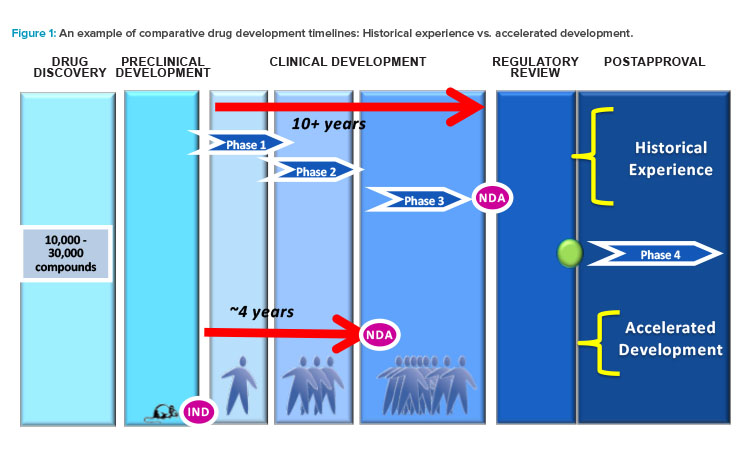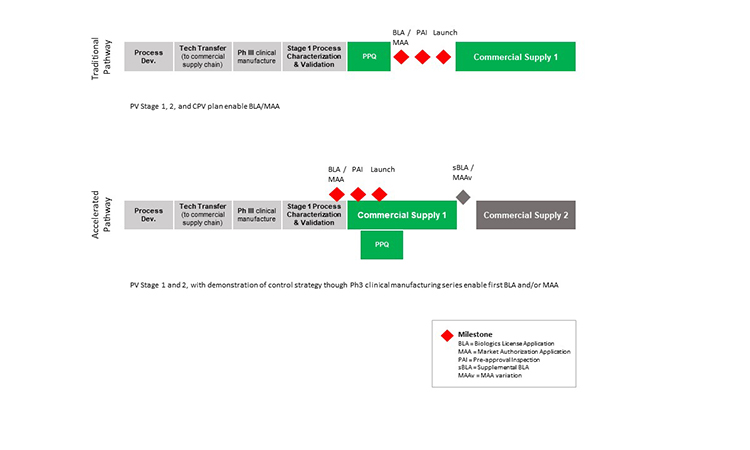Accelerated Pharma Product Development, Registration, Commercialization & Life Cycle

This article is Part 1 of a two-part series exploring what we can learn from examples of pharmaceutical products being approved using accelerated programs. The series focuses on challenges that chemistry, manufacturing, and control (CMC) development teams may encounter when a project is given accelerated development status. Part 1 introduces key considerations and themes in general terms and highlights future opportunities in accelerated pharmaceutical product development. In Part 2, which will be published in the next issue of Pharmaceutical Engineering, we will provide more detailed discussion of the considerations and themes and present several case studies.
Chemistry, Manufacturing, and Control Lessons, Part 1
The series concentrates on lessons from small chemical molecule (synthetic chemical) and biotechnological and biological molecule projects. However, many of the key considerations and themes will be applicable to those involved in development of newer, more advanced therapies. (Note: This article uses the terms “small molecule” and “large molecule” as shorthand for small chemical molecule [synthetic chemical], and biotechnological and biological molecule, respectively.)
During the past decade, there have been significant scientific and clinical advances resulting in more drugs being developed to treat patients’ unmet medical needs. These advances have led to patient expectations that these new drugs will be quickly made widely available. In response, regulators globally have developed improved regulatory pathways and issued guidances. However, as demonstrated in case studies, companies face significant challenges when managing postapproval changes globally. Such challenges can have a substantial impact on the supply chain and on a company’s pharmaceutical quality system (PQS).
Regulatory Trends and Development Implications
New regulatory guidelines intended to expedite the treatment of unmet medical needs through small molecule and large molecule products tend to fit broadly into two categories:
- Improvements to regulatory pathways
- Technical guidelines for newer types of advanced therapy (e.g., gene therapy)
Significant changes in regulatory pathways began in 2012, when the Breakthrough Therapy designation was included in the US Food and Drug Administration (FDA) Safety and Innovation Act1 . This development was followed by associated FDA guidance in 20142 , and the PRIME scheme3 , which launched in the European Union (EU) in 2016. These pathways and guidelines can streamline regulatory processes; however, there is potential for differences in interpretation of clinical entry requirements for the pathways, which could lead to inconsistencies in criteria for acceptance, and timing of acceptance, into the appropriate regulatory program.
Other countries and regions have also introduced expedited registration pathways4 . Examples of countries with accelerated pathways are:
The World Health Organization (WHO) has issued a collaborative procedure in the assessment and accelerated national registration of pharmaceutical products and vaccines approved by stringent regulatory authorities10 . Publications from other regulatory authorities (Brazil and Saudi Arabia) are listed in the references11 ,12 . In addition to these options for accelerating registration of medicinal products, the FDA issued a final guidance in 2018 on its Breakthrough Devices Program13 . This final guidance outlines program policies and features and describes the process for manufacturers pursuing the Breakthrough designation.
Regulators have been challenged to keep pace with the tremendous advances in medicine in the last two decades, which have resulted in ongoing development of novel modalities as clinical therapeutics. Cell therapies include both autologous and allogeneic approaches based on T cells, lymphocytes, antigen-presenting cells, and dendritic cells. The diverse array of other modalities includes oncolytic viruses, novel engineered antibodies, antibody-drug conjugates, protein machinery for gene editing, neoantigens, highly modified peptides, and nucleotide-based therapies (including mRNAs, small interfering RNAs [siRNAs], antisense oligonucleotides, and aptamers).
In 2017, the FDA introduced an additional expedited regulatory pathway applicable to advanced therapies, the Regenerative Medicine Advanced Therapy (RMAT) designation14 . For sponsors of a qualified regenerative medicinal product (i.e., cell therapy, therapeutic tissue engineering product, human cell and tissue product, or any combination product using such therapies or products) intended to treat serious or life-threatening conditions, RMAT can provide advantages similar to those of the Breakthrough Therapy designation, such as priority review and access to early and frequent interactions with the FDA.
To provide more technical guidance, in 2018 the European Medicines Agency (EMA) issued a revision of the Guideline on the Quality, Preclinical, and Clinical Aspects of Gene Therapy Medicinal Products15 . The quality section addresses mainly the specific requirements for the development and manufacture of a gene therapy medicinal product (GTMP). In this revision, the guideline has been completely reworked to give guidance on design, manufacture, characterization, and testing of a wider spectrum of delivery vectors (novel viral vectors, as well as nonviral and bacterial vectors).
Cross-regulatory authority interaction is occurring. For example, in November 2018, FDA representatives participated in a one-day workshop hosted by EMA, at which industry experts presented case studies of chemistry, manufacturing, and control challenges and approaches to accelerated development. A report of this workshop is anticipated later in 2019; slide presentations are currently available16 .
Recent efforts to streamline regulatory processes benefit sponsoring organizations and patients by expediting the approval of medically needed treatments (advancements). Case studies show that, because of the fluidity and evolving nature of the regulations, sponsors must negotiate with each regulatory authority separately on a case-by-case basis. This has to be done quickly so that output from the negotiations can be used as feedback to shape the evolving chemistry, manufacturing, and control project development plan. Practitioners tend to determine the latest requirements by directly contacting regulatory authorities. The websites of ICH and/or a regulatory authority may be helpful resources; however, these sites may not contain the latest information relevant to a sponsor's project.
Case studies demonstrate that chemistry, manufacturing, and control/quality-related issues are rate limiting for all modalities, and especially so for cell and gene therapies. Aside from safety-related issues that occur in the clinic, the greatest hurdle to approval for cell-based therapies is often not clinical efficacy, but chemistry, manufacturing, and control and manufacturing due to the nature of many of these therapies, their inherent high biological variability, and the speed of the development program. It seems that risk-based solutions for chemistry, manufacturing, and control issues for all modalities such as identity, potency, specification testing, stability, and comparability are being worked out one case at a time.
However, the regulatory expectations and regulations associated with the chemistry, manufacturing, and control portion of a submission for small chemical molecules and biotechnological and biological molecules as defined by the scope of ICH guidelines Q6A and Q6B17 ,18 have not changed.
A 2015 article by Dye and colleagues19 suggested that a regulatory filing for a drug in an expedited (accelerated) development program could be 18 to 24 months shorter than a conventional program, which would pose significant challenges for those parties responsible for delivering the normally expected chemistry, manufacturing, and control information. At that time, there were few examples of regulatory agencies having approved Breakthrough Therapy development programs at an early stage in development (i.e., after receipt of preclinical or early clinical positive information). Therefore, the paper by Dye and coauthors was based on examples—some real, some projected—of accelerated development of both small and large molecules. In the intervening period, companies and regulators have gained experience from actual cases of making exciting new medicines available to patients from accelerated development programs.
- 1Food and Drug Administration Safety and Innovation Act (FDASIA), Pub. L. 112-144 (2012).
- 2US Food and Drug Administration. “Guidance for Industry: Expedited Programs for Serious Conditions—Drugs and Biologics.” Published May 2014. https://www.fda.gov/regulatory-information/search-fda-guidance-documents/expedited-programs-serious-conditions-drugs-and-biologics
- 3European Medicines Agency Committee for Medicinal Products for Human Use. “Enhanced Early Dialogue to Facilitate Accelerated Assessment of PRIority MEdicines (PRIME).” EMA/CHMP/57760/2015, Rev. 1. Published May 2018. https://www.ema.europa.eu/documents/regulatory-procedural-guideline/enhanced-early-dialogue-facilitate-accelerated-assessment-priority-medicines-prime_en.pdf
- 4European Federation of Pharmaceutical Industries and Associations. “White Paper on Reliance and Expedited Registration Pathways in Emerging Markets.” Published November 2017. https://www.efpia.eu/media/288590/white-paper-on-reliance-and-expedited-registration-pathways-in-emerging-markets.docx
- 5Japanese Ministry of Health, Labour and Welfare. “Strategy of SAKIGAKE.” Published June 2014. https://www.mhlw.go.jp/english/policy/health-medical/pharmaceuticals/140729-01.html
- 6Australian Department of Health, Therapeutic Goods Administration. “Priority Review Pathway: Prescription Medicines.” Published 2 August 2018. https://www.tga.gov.au/priority-review-pathway-prescription-medicines
- 7Australian Department of Health, Therapeutic Goods Administration. “Priority Determination.” Published 3 August 2018. https://www.tga.gov.au/publication/priority-determination
- 8Health Canada Bureau of Policy Sciences and International Programs, Therapeutic Products Directorate. “Guidance for Industry—Priority Review of Drug Submissions.” Updated 6 February 2009. https://www.canada.ca/en/health-canada/services/drugs-health-products/drug-products/applications-submissions/guidance-documents/priority-review/drug-submissions.html
- 9Yao, X., J. Ding, Y. Liu, and P. Li. “The New Drug Conditional Approval Process in China: Challenges and Opportunities.” Clinical Therapeutics 39, no. 5 (2017):1040–51. doi:10.1016/j.clinthera.2017.03.016
- 10World Health Organization. “Collaborative Procedure in the Assessment and Accelerated National Registration of Pharmaceutical Products and Vaccines Approved by Stringent Regulatory Authorities.” WHO Technical Report Series, No. 1010, 2018, Annex 11. http://apps.who.int/medicinedocs/en/m/abstract/Js23456en
- 11da Silva, Jarbas Barbosa. “Regulatory Advances in Drug Regulation Accelerated Pathways of Approval.” Brazilian Health Regulatory Agency—ANVISA. Published 2018. http://portal.anvisa.gov.br/documents/219201/219401/ANVISA+JB+DIA+2018+Annual+Meeting+INGL%C3%8AS/4bea5429-ef3c-4b6a-9bb3-324896228c9e
- 12Saudi Arabia Food and Drug Authority. “Guidance for Priority Review of Product Registration, Version 2.” Published 24 October 2013. https://www.sfda.gov.sa/ar/drug/resources/DocLib2/ProrityReviewV2.pdf
- 13US Food and Drug Administration Center for Devices and Radiological Health. “Breakthrough Devices Program, Guidance for Industry and Food and Drug Administration Staff.” Published December 2018. https://www.fda.gov/regulatory-information/search-fda-guidance-documents/breakthrough-devices-program
- 14US Food and Drug Administration Center for Biologics Evaluation and Research. “Expedited Programs for Regenerative Medicine Therapies for Serious Conditions: Guidance for Industry.” Published February 2019. https://www.fda.gov/regulatory-information/search-fda-guidance-documents/expedited-programs-regenerative-medicine-therapies-serious-conditions
- 15European Medicines Agency Committee for Advanced Therapies. “Guideline on the Quality, Non-clinical and Clinical Aspects of Gene Therapy Medicinal Products.” EMA/CAT/80183/2014. Published 22 March 2018. https://www.ema.europa.eu/documents/scientific-guideline/guideline-quality-non-clinical-clinical-aspects-gene-therapy-medicinal-products_en.pdf
- 16“Stakeholder Workshop on Support to Quality Development in Early Access Approaches, such as PRIME and Breakthrough Therapies.” European Medicines Agency. 11 November 2018. https://www.ema.europa.eu/en/events/stakeholder-workshop-support-quality-development-early-access-approaches-such-prime-breakthrough
- 17International Council for Harmonisation of Technical Requirements for Pharmaceuticals for Human Use (ICH). “Specifications: Test Procedures and Acceptance Criteria for New Drug Substances and New Drug Products: Chemical Substances, Q6A.” Published 6 October 1999. https://www.ich.org/fileadmin/Public_Web_Site/ICH_Products/Guidelines/Quality/Q6A/Step4/Q6Astep4.pdf
- 18International Council for Harmonisation of Technical Requirements for Pharmaceuticals for Human Use (ICH). “Specifications: Test Procedures and Acceptance Criteria for Biotechnological/Biological Products, Q6B.” Published 10 March 1999. https://www.ich.org/fileadmin/Public_Web_Site/ICH_Products/Guidelines/Quality/Q6B/Step4/Q6B_Guideline.pdf
- 19Dye, E. S., J. Groskoph, B. Kelley, G. Millili, M. Nasr, C. J. Potter, E. Thostesen, and H. Vermeersch. “CMC Considerations when a Drug Development Project Is Assigned Breakthrough Therapy Status.” Pharmaceutical Engineering 35, no. 1 (2015): 22–36.

Regulators are taking a positive approach and supporting accelerated development regulatory pathways. For example, the FDA’s Center for Drug Evaluation and Research (CDER) approved 71 Breakthrough Therapy designations as of 31 December 2018 for original new drug applications (NDAs) and biologics license applications (BLAs) and the FDA’s Center for Biologics Evaluation and Research (CBER) approved 6 biologics license applications Breakthrough Therapy designations through 30 September 201820 , 21 . EMA accepted 48 medicines into the PRIME scheme as of 19 December 201822 .
Part 2 of this series will present an actual small molecule case study that illustrates how an accelerated pharmaceutical (clinical) program impacts the chemistry, manufacturing, and control program and its associated studies. In this case, the time from first dose in humans to new drug applications submission was about 4 years, whereas historical experience indicates that “typical” development timelines can take up to 10 years (see Figure 1).
Chemistry, Manufacturing, and Control Challenges, Key Considerations, and Themes
Like other stakeholders in the pharmaceuticals industry, ISPE recognizes the importance of accelerated development to patients, regulators, and manufacturers. Notably, the success of accelerated development programs has resulted in more instances where the chemistry, manufacturing, and control program is on the critical path to approval and supply to patients. Therefore, an ISPE team has been working for over a year on collating and sharing experiences among companies relating to the actual challenges faced by chemistry, manufacturing, and control development teams that are working to obtain initial approval while, at the same time, supplying products for ongoing and new clinical studies, and, most importantly, supplying products to patients globally.
Although each accelerated development program is unique and faces its own distinctive challenges, some chemistry, manufacturing, and control issues may be common to most or all programs. Review of the case studies on which this series of articles is based indicates typical chemistry, manufacturing, and control stress points are:
- The potential for suboptimal drug substance route/process and drug product formulation.
- Site readiness for commercial supply for a suboptimal process— for example, use of a clinical process and site to support initial submission, approval, and launch, followed by postapproval changes using an improved process, which is potentially developed in parallel with initial submission.
- The amount of stability data to support a practical shelf life at the time of approval.
- The process validation strategy, particularly for large molecules, where there may not be time to complete at least three batches manufactured at commercial scale with data submitted in the biologics license applications application.
- Setting specification acceptance criteria, particularly for a large molecule, where there may have been relatively few batches of product administered to patients.
- Studies and/or planned changes proposed to be conducted and submitted postapproval. This approach leads to great supply chain and regulatory complexity. For example, companies may need to use the clinical process to produce supplies for clinical studies, and potentially for the product launch, while simultaneously introducing a more efficient manufacturing process to supply patients more reliably. Supply chain issues, regulatory submissions, and, most importantly, approvals all must be juggled, which creates a significant resource and logistics burden, especially because the timing of approvals varies by region or country.
- The availability of resources, in terms of both quantities and levels of expertise. Depending on the company situation, resource issues may be partially mitigated by, for example, moving people from lower-priority projects (for a large company) or outsourcing. However, given the specific nature of the technology, it is highly unlikely that resources to support all desired studies can be accessed in the desired time frame.
Although there is no “one-size-fits-all” approach to accelerated development programs, some key considerations and themes can be highlighted from the case studies that inform this series of articles. Table 1 summarizes considerations of accelerated development programs, which include not only the expectations of regulatory authorities, but also the needs of the patient and company.
Underpinning many of these key considerations and themes is use of prior knowledge (for example, from platform processes or technology). There is also a need to accelerate the development of new knowledge to support justifications in discussions with regulatory authorities, regulatory applications, risk-management processes, and project planning. The case studies in Part 2 of this series will highlight where prior knowledge has been used, and one case study will show how computational modeling, simulation, and predictions can assist with decision-making and risk mitigation.
Future Opportunities
Case studies point to many opportunities for both companies and regulators to consider. ICH has started addressing some of these, as evidenced by the technical and regulatory considerations for the pharmaceutical product life cycle in ICH Q1223 . However, the scope of this ICH topic does not address the major challenges associated with postapproval changes, such as differences in the regulations themselves, differences in content requirements, and, most importantly, differences in time frames for approval to support certainty of making such changes.
Nonetheless, some flexibilities and lessons are emerging from accelerated product programs and approvals—which could be considered for wider adoption. Future opportunities include:
- More cooperative engagement between a sponsor of an accelerated development chemistry, manufacturing, and control program and regulators globally to agree on a harmonized chemistry, manufacturing, and control strategy.
- Use of a life-cycle approach to process and analytical validation for both small and large molecule programs.
- A global review of approvals granted via accelerated pathways, with the aim of expanding risk-based assessment and flexibility into all pharmaceutical development submission and approval processes. Risk-based regulatory decisions (reviews and inspections) were proposed in ICH topics Q8, Pharmaceutical Development and Q11, Development and Manufacture of Drug Substances.
- Harmonized guidelines for some aspects of novel modalities and advanced therapies.
| Key Consideration | Themes |
|---|---|
| Teamwork and project planning | Ensure support by all internal stakeholders. Engage in continual and extensive scenario planning and close monitoring of clinical data expectations. Plan for varying timelines in different countries. Evaluate risks and benefits. Consider a life-cycle approach. Evaluate supply chain options and manufacturing site selection and scale-up options. |
| Control strategy | Estimate and agree with authorities about the level of process and product understanding possible within the timeline. Leverage prior knowledge and platform technologies. Consider analytical readiness. Consider purity and continuity of supply of reference materials. Project how specifications will be justified, especially with low amounts of batch data. Estimate amounts of stability data that could be available at submission and during review. Consider starting material options for small molecule drug synthesis. |
| Process validation | Consider a life-cycle approach. Use a science- and risk-based approach to justify strategy. |
| Pharmaceutical quality system readiness | Consider pharmaceutical quality system readiness in line with site-selection strategy. Consider how pharmaceutical quality system can adapt to planned and unplanned postapproval changes. |
| Regulatory | Communicate with regulatory authorities as much as program requires and is possible. Use as many postapproval regulatory processes as possible and desirable to support a life-cycle strategy. Produce an easy-to-review dossier that contains scientific justifications and references and is in line with regulatory agreements. Consider the global filing strategy as part of the project plan. |
*In each category, many themes are common to large and small molecules; however, some are specific to a type of molecule. More detailed discussion and considerations for chemistry, manufacturing, and control development teams will be given in Part 2 of this series.
- 20US Food and Drug Administration. “CDER Breakthrough Therapy Designation Approval as of December 31, 2018.” https://www.fda.gov/downloads/Drugs/DevelopmentApprovalProcess/HowDrugsareDevelopedandApproved/DrugandBiologicApprovalReports/NDAandBLAApprovalReports/UCM494010.pdf
- 21US Food and Drug Administration. “CBER Breakthrough Therapy Designation Approvals.” Updated 28 March 2018. https://www.fda.gov/RegulatoryInformation/LawsEnforcedbyFDA/SignificantAmendmentstotheFDCAct/FDASIA/ucm413991.htm
- 22European Medicines Agency. “Data for Entry into PRIME Scheme.” Updated 16 May 2019.https://www.ema.europa.eu/documents/report/list-products-granted-eligibility-prime_en-0.xlsx
- 23International Council for Harmonisation of Technical Requirements for Pharmaceuticals for Human Use (ICH). “ICH Q12, Technical and Regulatory Considerations for Pharmaceutical Product Lifecycle Management, Step 2.” Published 16 November 2017. https://www.ich.org/products/guidelines/quality/quality-single/article/technical-and-regulatory-considerations-for-pharmaceutical-product-lifecycle-management.html

Improving Cooperative Engagement Between Sponsors and Regulators Globally
Currently, sponsors of products have multiple pathways for communication with the FDA; however, similar levels of interaction with EMA regulators are not always easily achievable. Additionally, sponsors lack assurance that different regulators share the same expectations and requirements for a proposed chemistry, manufacturing, and control program.
For sponsors of accelerated development programs, establishing a global chemistry, manufacturing, and control program is a key future step.
Process Validation
Regulatory authorities have sometimes granted, on a case-by-case basis, flexibility in the timing of process validation studies for some large molecule approvals from accelerated programs. Consideration should be given to using risk-based criteria to extend flexibility in the timing of process validation studies to all molecules.
Currently, in the United States and EU, an absolute requirement at the time of file for a biological/biotechnology molecule is that process performance qualification (PPQ) (stage 2) must be included in the submission. An open question is whether some flexibility could be employed.
For example, if pivotal supplies of drug substance and drug product have been manufactured in the commercial supply chain and the subsequent process characterization does not lead to significant alterations of the process, the pivotal batches could perhaps be considered adequate, repeated demonstration that the process control strategy will reliably deliver a drug substance and product that meet the predetermined acceptance criteria. Resulting satisfactory stability data supportive of the commercial shelf life might provide further evidence to support the process control strategy. Performance qualification data could then be provided during the review cycle (as is common for new chemical entities) or within a biologics license applications supplement or marketing authorization application (MAA) variation.
Figure 2 highlights examples of potential chemistry, manufacturing, and control challenges by comparing traditional and accelerated pathways for large molecule process development and validation. A traditional large molecule development approach to process development and validation is given in the top line of Figure 2. The bottom line shows a generalized chemistry, manufacturing, and control program for an accelerated pathway, such as one arising after Breakthrough designation is granted for a large molecule after promising phase 1 clinical data demonstrating efficacy. In the accelerated case, stage 2, performance qualification, is proposed in parallel with biologics license applications review and preapproval inspection (PAI).
While the specifics of process validation are critical to agreements reached between sponsor and regulatory authority, a generalized model can be used for illustrative purposes. Nomenclature is based on US Process Validation Guidance24 .
Important to the strategy is the degree of control strategy understanding that accumulates during process development and that can be demonstrated adequately during pivotal manufacture, especially when the drug substance and product are manufactured in the intended launch facilities and supported by validated methods. In this scenario, it may be possible to propose filing the biologics license applications and support the preapproval inspection concurrent with stage 2 performance qualification manufacture.
This type of scenario calls into question the rigidity of modality-specific validation requirements. Traditionally, sponsors preparing a biologics license applications and/or marketing authorization application filing for biological/biotechnological products have considered the completion of at least three performance qualification batches to be a required component of process validation for successful market authorization. In contrast, for small molecule products, it has long been considered acceptable to develop performance qualification data during review or as a postapproval commitment; although in the EU, validation data for “nonstandard” products also must be provided in the marketing authorization application. This difference in expectations is perhaps owing to the difference in the risk-profiles between the two modalities, and the fact that the small molecule products can often be fully characterized using a relatively small set of validated analytical techniques. In decades past, the inherent molecular heterogeneity of biotechnological products led to the now-outdated common wisdom that the “product is the process.” As analytical techniques have significantly improved understanding of the structure-function relationship of some biotechnological products, understanding of the effect of product-related variants on the mechanism of action of a proposed therapy has also expanded. Because of this in-depth characterization, coupled with more extensive experimental design within a quality-by-design (QbD) framework and expanding adoption of platform processes (which may include process analytical technology, where possible), the robustness of well-defined end-to-end control strategies has improved, and the predictive ability related to process variability on critical quality attributes has become more precise.
This is all part of the overall process validation strategy, and the life-cycle approach itself refutes the idea that validation is solely based on a small, discrete number of batches manufactured under protocol; instead, validation relies on a continually expanding body of process understanding. Industry case studies demonstrate that in certain circumstances, which are partially determined by the severity of a disease and the degree of unmet medical need, regulators are willing to consider, and indeed approve, market authorization without a full complement of performance qualification data or other components previously considered requirements. Instead, sponsors and authorities are jointly reviewing the body of evidence of process control understanding and product quality and making risk-based decisions to determine the point at which the sponsor has, or will have, gathered adequate evidence to warrant market authorization and meet the postapproval obligations necessary to demonstrate that the product is in a continual state of validated control and suitable for administration to patients.
Global Review of Chemistry, Manufacturing, and Control Expectations
The database of approvals of accelerated programs in which sponsors and authorities have used science- and risk-based approaches to submit and review drug product submissions is expanding. From these data, we can identify lessons more broadly applicable to a wider range of drug development programs. A starting point could be the process validation topic, especially as applied to well-characterized biotechnological molecules. Other opportunities could be stability requirements for small molecule drug substances and products, and acceptance criteria for impurities in specifications for small molecule drug substances. These topics could fall under the ICH umbrella, because all except process validation are current ICH topics.
Harmonized Guidelines for Advanced Therapies
The expanding number of approvals globally of advanced therapies also may present opportunities, again potentially under the ICH umbrella, to develop helpful guidelines for the chemistry, manufacturing, and control-equivalent parts of development and submission. ICH topic M6, Guideline on Virus and Gene Therapy Vector Shedding and Transmission, was started in 2009; however, it ceased in 2011 because of issues related to the state of science and resource allocation at that time.
Notably, the EMA Guideline on the Quality, Non-clinical and Clinical Aspects of Gene Therapy Medicinal Products15 contains a section on quality aspects. This could be a starting point for a global harmonization initiative.
Summary: Evolving from Modality-Specific to Risk-Specific Requirements
The industry may be evolving toward a scenario in which the decisions regarding the specific requirements to be included at the time of file should be risk specific, not modality specific. Rather than using a lexicon of categorically defined requirements for a biological/biotechnological product or a small chemical molecule, the discussions surrounding the development of a therapy for an unmet medical need should progress quickly to the best strategy of balancing patient needs with the process and product understanding at the time of file and a strategy of sequential discharge of both clinical and chemistry, manufacturing, and control risk. This concept of jointly owned decision-making responsibility between the sponsor and regulatory authority could enable acceleration of process development and unique, collaborative approaches to the validation and filing strategy.
Conclusion
Drawing from the lessons learned from case studies of approvals of drug products developed and approved using accelerated pathways, the ISPE team has produced key considerations and themes regarding chemistry, manufacturing, and control challenges of accelerated development, which should be of benefit to other practitioners and chemistry, manufacturing, and control teams. These lessons and the key considerations apply to both small molecule and biological/biotechnological developments and may be applicable to advanced therapy programs.
At a high level, current model drug development paradigms and associated regulatory pathways may be inadequate to accommodate the rapid advances in personalized medicine and the ever-expanding array of diverse modalities, which show great clinical promise in addressing a variety of unmet medical needs. Chemistry, manufacturing, and control regulatory flexibility in these types of submissions is therefore warranted to expedite global availability of these medicines to patients.
From these lessons, future opportunities have been identified, including some that could be applied specifically to accelerated development programs and some that could be applied to all drug development programs. Examples are:
- Review of current chemistry, manufacturing, and control regulatory requirements for submission (for example, process development requirements at time of submission for well-characterized biotechnological molecules; stability requirements for small molecules; and acceptance criteria, particularly impurities, for small molecule in specifications).
- More use of regulatory pathways based on approvals in Stringent Regulatory Authorities, as proposed by WHO, EFPIA, and others.
- Improved communication between regulatory authorities to ensure that chemistry, manufacturing, and control development programs are applicable globally.
- Review of postapproval regulations to improve efficiency and certainty relating to planned postapproval changes.
- 24US Food and Drug Administration. “Guidance for Industry—Process Validation: General Principles and Practices.” Published January 2011. https://www.fda.gov/regulatory-information/search-fda-guidance-documents/process-validation-general-principles-and-practices
- 15


